A Novel Energy-Intensity Model Based on Time Scale for Quasi-Continuous Production in Iron and Steel Industry
Abstract
1. Introduction
2. Methodology
2.1. The Determination of Statistical Period and Time Scale
2.1.1. The Determination of Statistical Period
2.1.2. The Determination of Time Scale
2.2. NEIM Establishment in Some Time Scale
- (1)
- Statistical period ();
- (2)
- Time scale (), in which time interval ;
- (3)
- Time scale () Statistical period ().
2.3. Calculation at the Time Scale
2.4. Calculation in Time Scale
2.4.1. No Change in the Number of Workpieces
2.4.2. Change in the Number of Workpieces
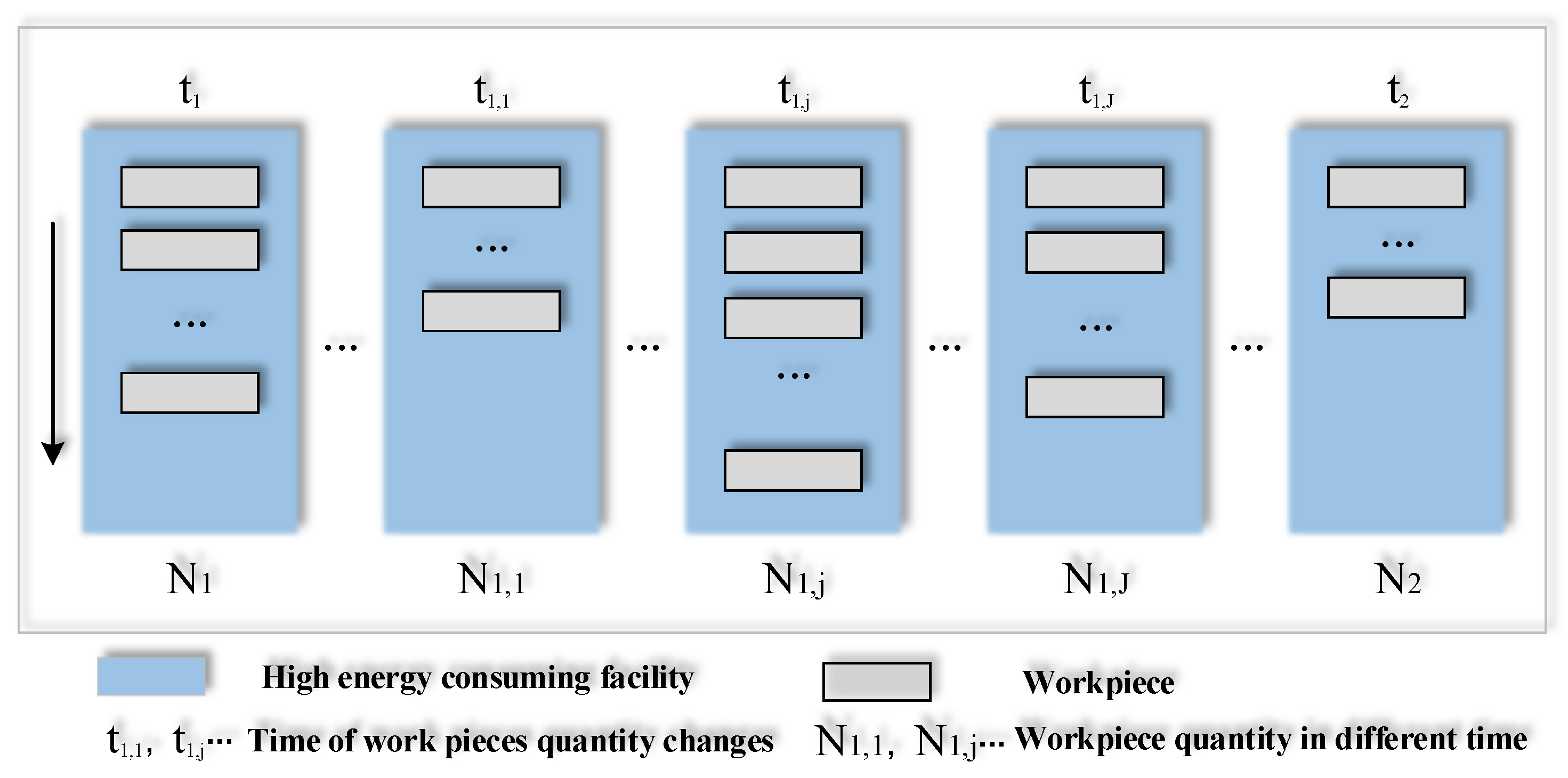
3. Case Study
3.1. The Division of Different Time Scales
3.2. The Energy-Intensity Calculation Results in Different Time Scales
3.3. The Validity of this NEIM
3.3.1. Computational-Performance Analysis of Two Energy-Intensity Models at Different Time Scales
- (1)
- LTS region
- (2)
- CTS region
- (3)
- STS region
3.3.2. NEIM Validity Analysis at Different Time Scales
- (1)
- NEIM validity analysis in the LTS and CTS regions
- (2)
- NEIM validity analysis in the STS region
3.3.3. Summary
4. Discussion
4.1. Time Scale and Information Expression
4.1.1. Production Status Information Loss
4.1.2. Other Dynamic Information Loss
4.2. Energy Intensity Transient Dynamic Characteristics at STS
4.2.1. Shutdown Process
4.2.2. Commencement Process
5. Conclusions
- (1)
- On the basis of characteristics of quasi-continuous production, NEIM has been established. Through the comparative analysis of the validity with TEIM, NEIM has wider applicability at different time scales. In particular, TEIM has failed at STS, whereas NEIM is still valid.
- (2)
- The application of NEIM for reheating furnaces at different time scales (10 min, 30 min, 1 h, 2 h, 4 h, 8 h, 1 day, 7 days, 14 days, 28 days) shows that energy-intensity calculation results reflect more trend information at LTS, whereas production status information has been completely lost in some LTSs (7 days, 14 days, 28 days). Meanwhile, the energy-intensity calculation results can express clearer representation of production-status information in some STSs, especially for 10 min STS or 30 min STS during shutdown and commencement process.
- (3)
- According to the physical demand, TEIM and NEIM can be selected. Significantly, these two models have different data requirements. On the one hand, TEIM only requires production data and energy consumption data during statistical periods. On the other hand, energy intensity can be calculated by combing specific manufacturing-technology and production-process data. Therefore, NEIM requires better data requirements than TEIM.
- (4)
- NEIM can be applied not only to quasi-continuous production such as reheating furnaces, but also to other similar production processes. Furthermore, through energy-intensity calculation at different time scales, energy-supply-strategy rationality can be further evaluated and discussed for different energy consuming facilities.
Author Contributions
Funding
Data Availability Statement
Acknowledgments
Conflicts of Interest
References
- Heffron, R.; Körner, M.F.; Wagner, J.; Weibelzahl, M.; Fridgen, G. Industrial demand-side flexibility: A key element of a just energy transition and industrial development. Appl. Energy 2020, 269, 115026. [Google Scholar] [CrossRef]
- Han, J.; Du, B. Analysis method of influence of iron steel ratio change on comprehensive energy consumption per ton of steel. Iron Steel 2022, 57, 188–194. [Google Scholar]
- Ghasemi-Mobtaker, H.; Mostashari-Rad, F.; Saber, Z.; Chau, K.W.; Nabavi-Pelesaraei, A. Application of photovoltaic system to modify energy use, environmental damages and cumulative exergy demand of two irrigation systems—A case study: Barley production of Iran. Renew. Energy 2020, 160, 1316–1334. [Google Scholar] [CrossRef]
- Zhang, Q.; Wang, X.; Xu, L.; Shen, J. Analysis on coupling relationship of resource-energy-carbon emissions in steel production. Iron Steel 2020, 55, 103–114. [Google Scholar]
- Islam, S.; Al-Amin, A.Q.; Sarkar, S.K. Energy crisis in Bangladesh: Challenges, progress, and prospects for alternative energy resources. Util. Policy 2021, 71, 101221. [Google Scholar] [CrossRef]
- Poudyal, R.; Loskot, P.; Nepal, R.; Parajuli, R.; Khadka, S.K. Mitigating the current energy crisis in Nepal with renewable energy sources. Renew. Sustain. Energy Rev. 2019, 116, 109388. [Google Scholar] [CrossRef]
- Wang, Q.; Li, S.; Pisarenko, Z. Heterogeneous effects of energy efficiency, oil price, environmental pressure, R&D investment, and policy on renewable energy—Evidence from the G20 countries. Energy 2020, 209, 118322. [Google Scholar]
- Zhao, X.; Ma, X.; Chen, B.; Shang, Y.; Song, M. Challenges toward carbon neutrality in China: Strategies and countermeasures. Resour. Conserv. Recycl. 2022, 176, 105959. [Google Scholar] [CrossRef]
- Lu, B.; Tang, K.; Chen, D.; Han, Y.; Wang, S.; He, X.; Chen, G. A novel approach for lean energy operation based on energy apportionment model in reheating furnace. Energy 2019, 182, 1239–1249. [Google Scholar] [CrossRef]
- Zhang, S.; Zhao, L.; Feng, J.; Luo, X.; Dong, H. Thermal analysis of sinter vertical cooler based on waste heat recovery. Appl. Therm. Eng. 2019, 157, 113708. [Google Scholar] [CrossRef]
- Liu, X.; Chen, L.; Feng, H.; Qin, X.; Sun, F. Constructal design of a blast furnace iron-making process based on multi-objective optimization. Energy 2016, 109, 137–151. [Google Scholar] [CrossRef]
- Li, Z.; Zhang, X.; Lai, N.-C.; Jiang, Z.; Li, J. A novel process for coke wastewater gasification quenching: Energy and exergy analysis. Appl. Therm. Eng. 2021, 191, 116863. [Google Scholar] [CrossRef]
- Hu, Z.; Qu, A.; Zhong, Z.; Zhang, X.; Peng, H.; Li, J. Study on pulverized coal gasification using waste heat from high temperature blast furnace slag particles. Int. J. Hydrogen Energy 2021, 46, 26848–26860. [Google Scholar] [CrossRef]
- Ji, W.; Li, G.; Wei, L.; Yi, Z. Modeling and determination of total heat exchange factor of regenerative reheating furnace based on instrumented slab trials. Case Stud. Therm. Eng. 2021, 24, 100838. [Google Scholar] [CrossRef]
- Jiang, H.-B.; Zhang, J.-L.; Fu, J.-X.; Chang, J.; Li, J. Properties and Structural Optimization of Pulverized Coal for Blast Furnace Injection. J. Iron Steel Res. Int. 2011, 18, 6–12. [Google Scholar] [CrossRef]
- Koohestanian, E.; Shahraki, F. Review on principles, recent progress, and future challenges for oxy-fuel combustion CO2 capture using compression and purification unit. J. Environ. Chem. Eng. 2021, 9, 105777. [Google Scholar] [CrossRef]
- An, R.; Yu, B.; Li, R.; Wei, Y.-M. Potential of energy savings and CO2 emission reduction in China’s iron and steel industry. Appl. Energy 2018, 226, 862–880. [Google Scholar] [CrossRef]
- Amaris, C.; Miranda, B.; Balbis-Morejón, M. Experimental thermal performance and modelling of a waste heat recovery unit in an energy cogeneration system. Therm. Sci. Eng. Prog. 2020, 20, 100684. [Google Scholar] [CrossRef]
- Al-Janabi, A.; Al-Hajri, G.; Al-Maashani, T. Investigate the technical-economical feasibility of utilizing the available industrial waste themal energy in Oman. Therm. Sci. Eng. Prog. 2021, 21, 100778. [Google Scholar] [CrossRef]
- Zhang, Q.; Wei, Z.; Ma, J.; Qiu, Z.; Du, T. Optimization of energy use with CO2 emission reducing in an integrated iron and steel plant. Appl. Therm. Eng. 2019, 157, 113635. [Google Scholar] [CrossRef]
- Lu, B.; Chen, G.; Chen, D.; Yu, W. An energy intensity optimization model for production system in iron and steel industry. Appl. Therm. Eng. 2016, 100, 285–295. [Google Scholar] [CrossRef]
- Jin, T. Impact of heat and electricity consumption on energy intensity: A panel data analysis. Energy 2021, 239, 121903. [Google Scholar] [CrossRef]
- Calcagnini, G.; Giombini, G.; Travaglini, G. Modelling energy intensity, pollution per capita and productivity in Italy: A structural VAR approach. Renew. Sustain. Energy Rev. 2016, 59, 1482–1492. [Google Scholar] [CrossRef]
- Na, H.; Sun, J.; Qiu, Z.; He, J.; Yuan, Y.; Yan, T.; Du, T. A novel evaluation method for energy efficiency of process industry—A case study of typical iron and steel manufacturing process. Energy 2021, 233, 121081. [Google Scholar] [CrossRef]
- Khalid, Y.; Wu, M.; Silaen, A.; Martinez, F.; Okosun, T.; Worl, B.; Low, J.; Zhou, C.; Johnson, K.; White, D. Oxygen enrichment combustion to reduce fossil energy consumption and emissions in hot rolling steel production. J. Clean. Prod. 2021, 320, 128714. [Google Scholar] [CrossRef]
- Assawamartbunlue, K.; Surawattanawan, P.; Luknongbu, W. Specific energy consumption of cement in Thailand. Energy Procedia 2019, 156, 212–216. [Google Scholar] [CrossRef]
- Molinos-Senante, M.; Sala-Garrido, R. Evaluation of energy performance of drinking water treatment plants: Use of energy intensity and energy efficiency metrics. Appl. Energy 2018, 229, 1095–1102. [Google Scholar] [CrossRef]
- Shahiduzzaman, M.; Alam, K. Changes in energy efficiency in Australia: A decomposition of aggregate energy intensity using logarithmic mean Divisia approach. Energy Policy 2013, 56, 341–351. [Google Scholar] [CrossRef]
- Sandoval-García, E.; Matsumoto, Y.; Sánchez-Partida, D. Data and energy efficiency indicators of freight transport sector in Mexico. Case Stud. Transp. Policy 2021, 9, 1336–1343. [Google Scholar] [CrossRef]
- Su, B.; Goh, T.; Ang, B.W.; Ng, T.S. Energy consumption and energy efficiency trends in Singapore: The case of a meticulously planned city. Energy Ploicy 2022, 161, 112732. [Google Scholar] [CrossRef]
- Paramati, S.R.; Shahzad, U.; Doğan, B. The role of environmental technology for energy demand and energy efficiency: Evidence from OECD countries. Renew. Sustain. Energy Rev. 2021, 153, 111735. [Google Scholar] [CrossRef]
- Sun, X.; Jia, M.; Xu, Z.; Liu, Z.; Liu, X.; Liu, Q. An investigation of the determinants of energy intensity in emerging market countries. Energy Strat. Rev. 2021, 39, 100790. [Google Scholar] [CrossRef]
- Wen, H.; Li, N.; Lee, C.-C. Energy intensity of manufacturing enterprises under competitive pressure from the informal sector: Evidence from developing and emerging countries. Energy Econ. 2021, 104, 105613. [Google Scholar] [CrossRef]
- Shokoohi, Z.; Dehbidi, N.K.; Tarazkar, M.H. Energy intensity, economic growth and environmental quality in populous Middle East countries. Energy 2022, 239, 122164. [Google Scholar] [CrossRef]
- Yu, S.; Liu, J.; Hu, X.; Tian, P. Does development of renewable energy reduce energy intensity? Evidence from 82 countries. Technol. Forecast. Soc. Chang. 2021, 174, 121254. [Google Scholar] [CrossRef]
- Wang, E.Z.; Lee, C.C.; Li, Y. Assessing the impact of industrial robots on manufacturing energy intensity in 38 countries. Energy Econ. 2021, 105, 105748. [Google Scholar] [CrossRef]
- Lu, B.; Zhao, Y.; Chen, D.; Li, J.; Tang, K. A novelty data mining approach for multi-influence factors on billet gas consumption in reheating furnace. Case Stud. Therm. Eng. 2021, 26, 101080. [Google Scholar] [CrossRef]
- Hasanbeigi, A.; Price, L.; Chunxia, Z.; Aden, N.; Xiuping, L.; Fangqin, S. Comparison of iron and steel production energy use and energy intensity in China and the U.S. J. Clean. Prod. 2014, 65, 108–119. [Google Scholar] [CrossRef]
- Liu, H.; Ren, Y.; Wang, N. Energy efficiency rebound effect research of China’s coal industry. Energy Rep. 2021, 7, 5475–5482. [Google Scholar] [CrossRef]
- Lipiäinen, S.; Kuparinen, K.; Sermyagina, E.; Vakkilainen, E. Pulp and paper industry in energy transition: Towards energy-efficient and low carbon operation in Finland and Sweden. Sustain. Prod. Consum. 2021, 29, 421–431. [Google Scholar] [CrossRef]
- Foroushani, S.; Owen, J.; Bahrami, M. Data-driven modelling of operational district energy networks. Therm. Sci. Eng. Prog. 2020, 22, 100802. [Google Scholar] [CrossRef]
- Lu, B.; Chen, D.; Chen, G.; Yu, W. An energy apportionment model for a reheating furnace in a hot rolling mill—A case study. Appl. Therm. Eng. 2017, 112, 174–183. [Google Scholar] [CrossRef]
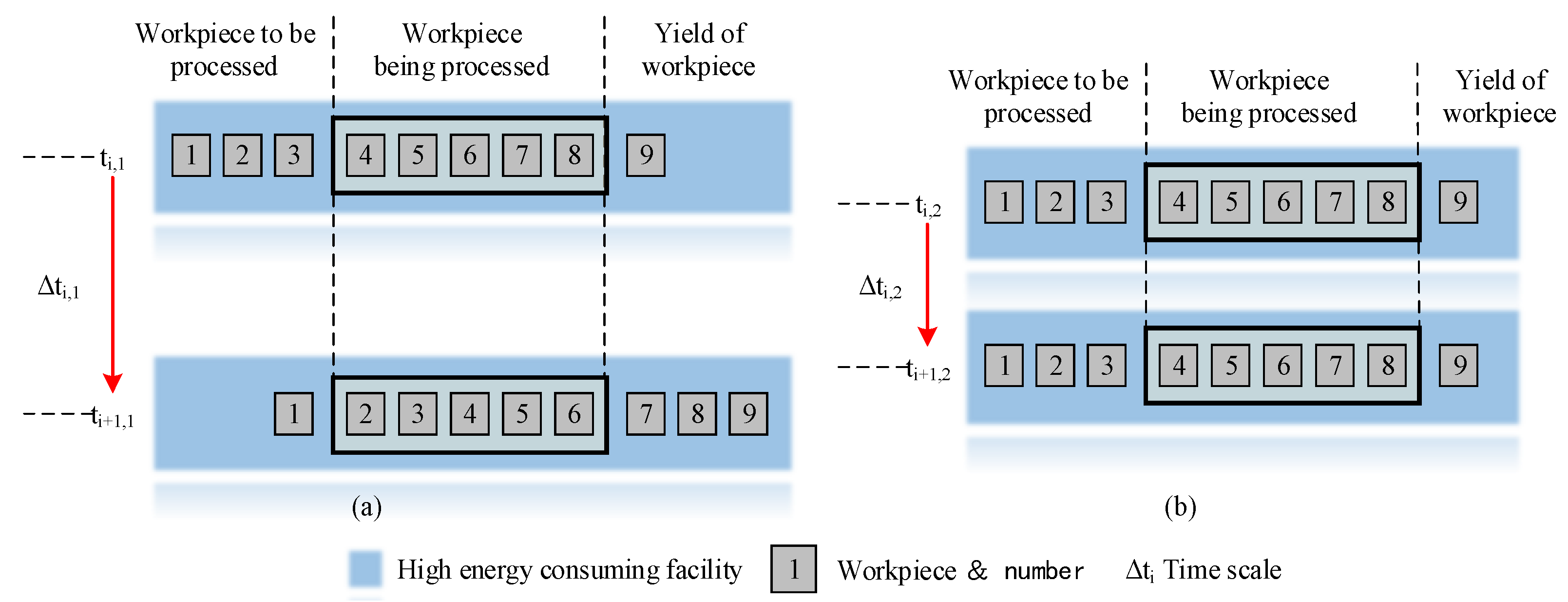
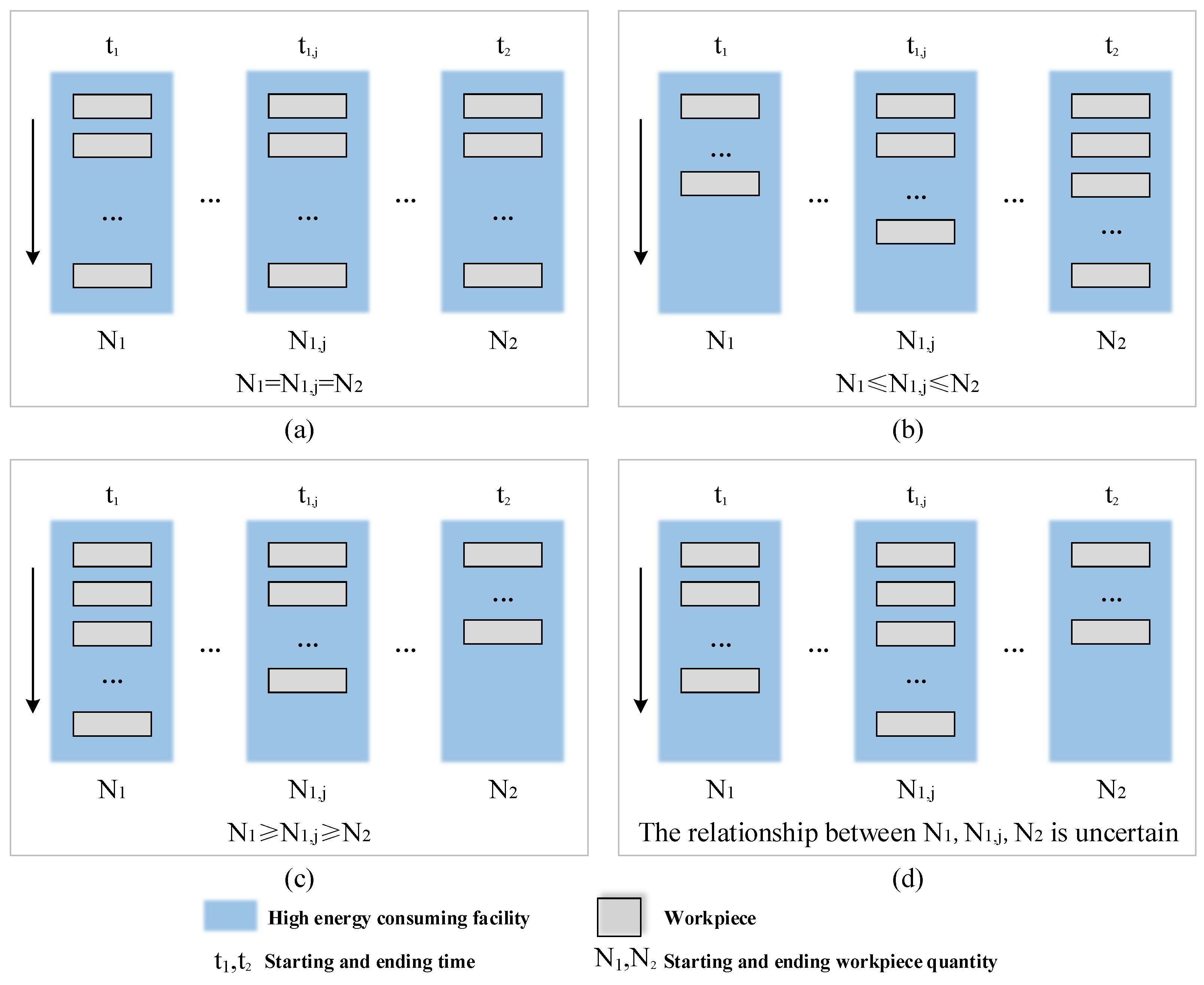

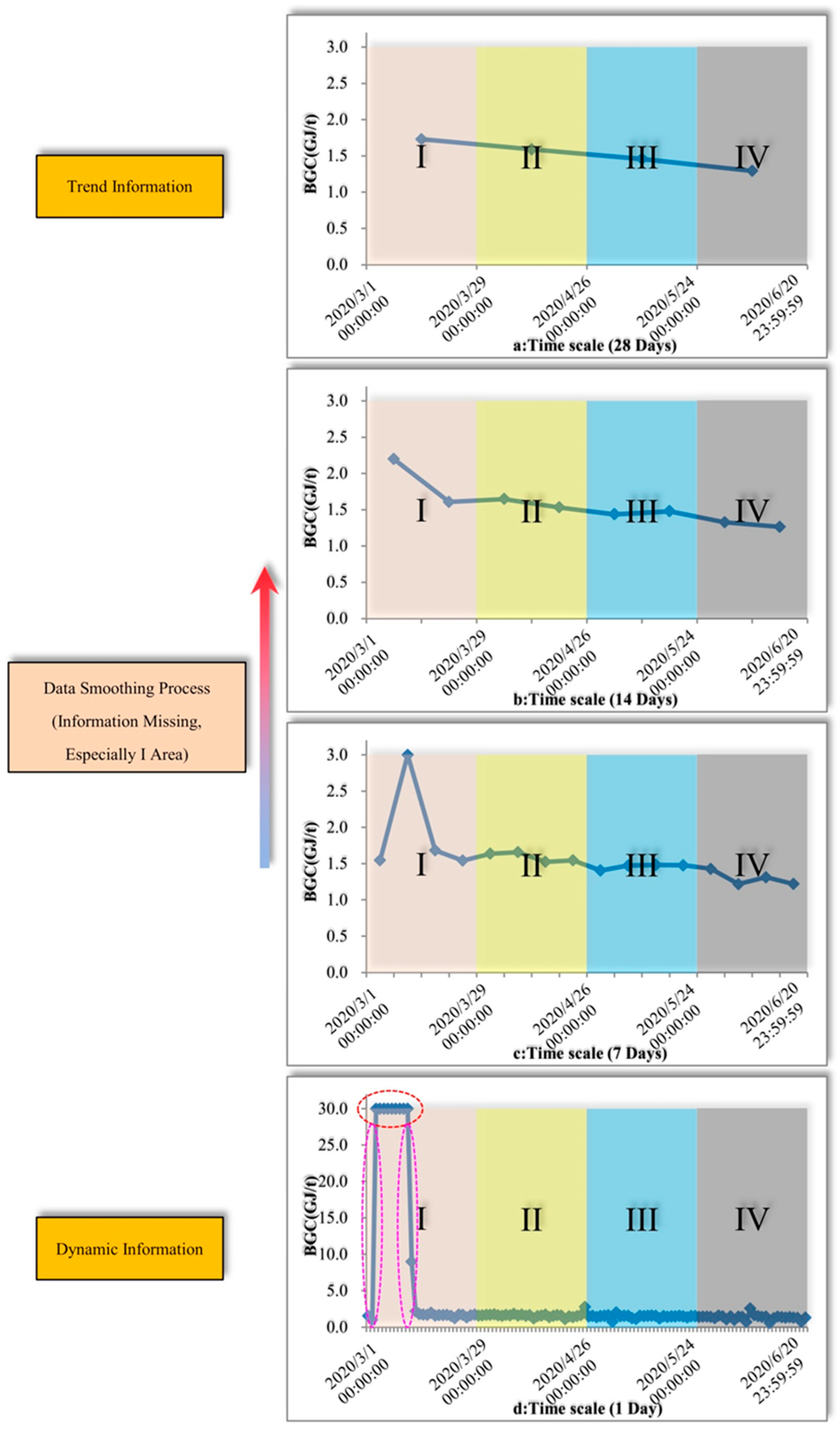
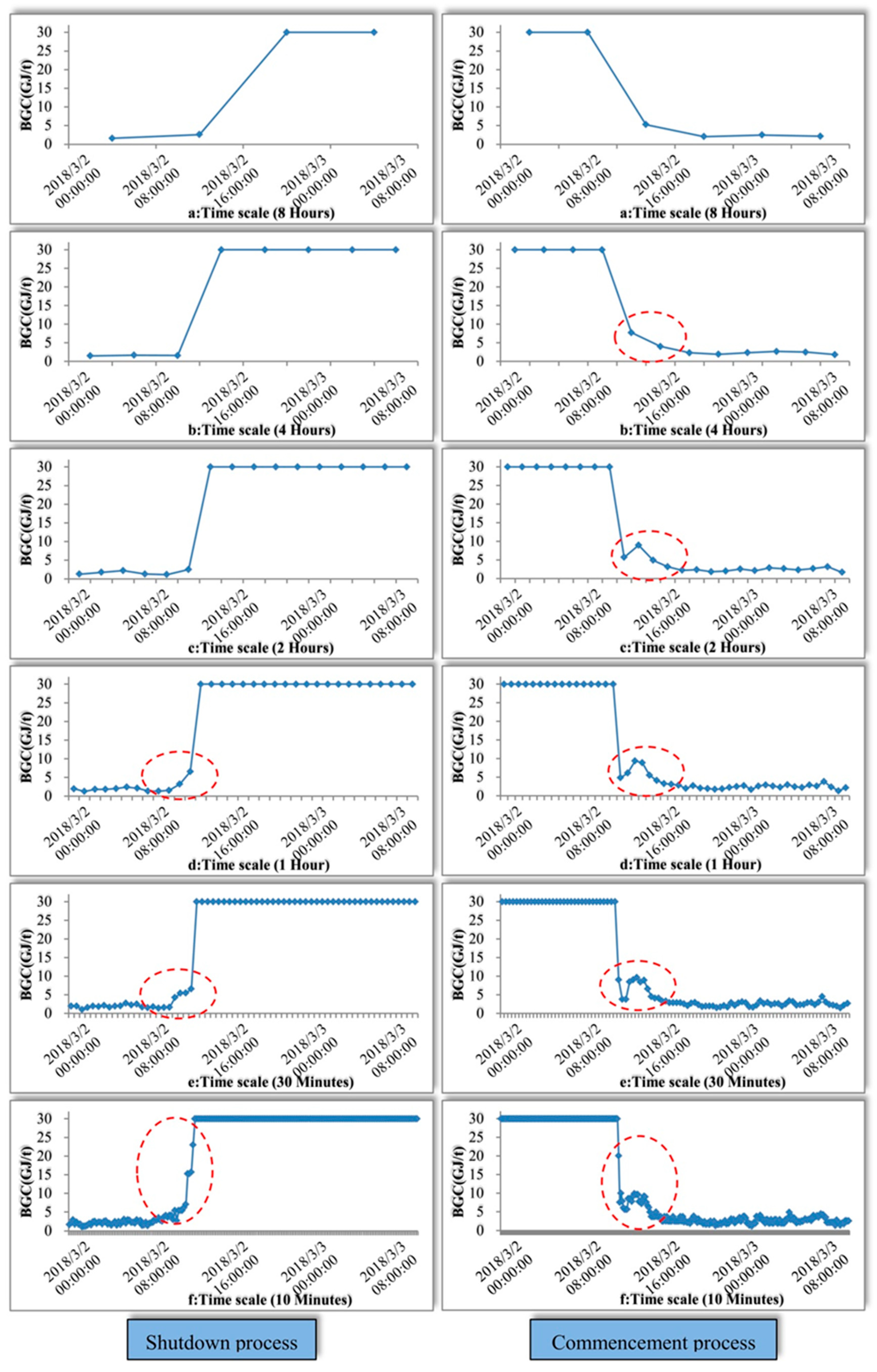
| No. | No. | ||
|---|---|---|---|
| 1 | 5 min | 7 | 8 h |
| 2 | 10 min | 8 | 1 day |
| 3 | 30 min | 9 | 7 days |
| 4 | 1 h | 10 | 14 days |
| 5 | 2 h | 11 | 28 days |
| 6 | 4 h |
| No. | Time Scale | Average Value (GJ/t) | Standard Deviation | Variation Coefficient | |||
|---|---|---|---|---|---|---|---|
| Novelty | Tradition | Novelty | Tradition | Novelty | Tradition | ||
| 1 | 28 Days | 1.52 | 1.52 | 0.186 | 0.093 | 0.123 | 0.061 |
| 2 | 14 Days | 1.56 | 1.57 | 0.288 | 0.254 | 0.185 | 0.162 |
| 3 | 7 Days | 1.57 | 1.57 | 0.405 | 0.315 | 0.257 | 0.201 |
| 4 | 1 Days | 1.49 | 1.58 | 0.275 | 0.774 | 0.185 | 0.491 |
| 5 | 8 h | 1.58 | 1.83 | 0.444 | 1.579 | 0.280 | 0.864 |
| 6 | 4 h | 1.60 | 2.11 | 0.658 | 2.245 | 0.412 | 1.065 |
| 7 | 2 h | 1.72 | 2.28 | 0.798 | 2.532 | 0.464 | 1.111 |
| 8 | 1 h | 1.76 | 2.48 | 0.867 | 2.777 | 0.492 | 1.122 |
| 9 | 30 min | 1.82 | 2.66 | 0.956 | 3.016 | 0.524 | 1.133 |
| 10 | 10 min | 1.96 | 3.05 | 1.135 | 3.489 | 0.578 | 1.145 |
Disclaimer/Publisher’s Note: The statements, opinions and data contained in all publications are solely those of the individual author(s) and contributor(s) and not of MDPI and/or the editor(s). MDPI and/or the editor(s) disclaim responsibility for any injury to people or property resulting from any ideas, methods, instructions or products referred to in the content. |
© 2023 by the authors. Licensee MDPI, Basel, Switzerland. This article is an open access article distributed under the terms and conditions of the Creative Commons Attribution (CC BY) license (https://creativecommons.org/licenses/by/4.0/).
Share and Cite
Lu, B.; Hao, Y.; Wang, H.; Chen, D.; Wang, X.; Li, N. A Novel Energy-Intensity Model Based on Time Scale for Quasi-Continuous Production in Iron and Steel Industry. Processes 2023, 11, 1823. https://doi.org/10.3390/pr11061823
Lu B, Hao Y, Wang H, Chen D, Wang X, Li N. A Novel Energy-Intensity Model Based on Time Scale for Quasi-Continuous Production in Iron and Steel Industry. Processes. 2023; 11(6):1823. https://doi.org/10.3390/pr11061823
Chicago/Turabian StyleLu, Biao, Yongkang Hao, Hao Wang, Demin Chen, Xingyin Wang, and Ning Li. 2023. "A Novel Energy-Intensity Model Based on Time Scale for Quasi-Continuous Production in Iron and Steel Industry" Processes 11, no. 6: 1823. https://doi.org/10.3390/pr11061823
APA StyleLu, B., Hao, Y., Wang, H., Chen, D., Wang, X., & Li, N. (2023). A Novel Energy-Intensity Model Based on Time Scale for Quasi-Continuous Production in Iron and Steel Industry. Processes, 11(6), 1823. https://doi.org/10.3390/pr11061823





